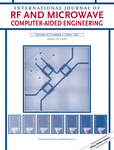A millimeter-wave dual-polarized stacked patch antenna with enhanced bandwidth and low profile
Funding information: Nantong Science and Technology Plan Project, Grant/Award Number: JC2020138; Natural Science Research Project of Jiangsu Higher Education Institutions, Grant/Award Number: 20KJB510004; Postgraduate Research & Practice Innovation Program of Jiangsu Province, Grant/Award Number: KYCX20_2791 KYCX19_2054
Abstract
A millimeter-wave (mm-wave) dual-polarized antenna achieved by stacking single patch and 2 × 2 patches with square holes is proposed to achieve low profile and wide bandwidth. The single patch and the 2 × 2 patches operate at two pairs of orthogonal modes, TM10/TM01 modes and antiphase TM20/TM02 modes, respectively. The square holes are introduced to adjust the coupling between the two layers of patches with small spacing. The appropriate coupling between two layers of patches and the low quality factor of the upper 2 × 2 patches make the proposed antenna achieve wide bandwidth with relatively low profile. A pair of perturbation slots is introduced to adjust the port-to-port isolation. The characteristic mode analysis (CMA) method is utilized to analyze the antenna element to reveal the modal behavior of the proposed antenna. For demonstration, a prototype of 2 × 2 array with a profile of 0.05λ0 (λ0 is the wavelength in free space at the center frequency) is designed and fabricated, which achieves the measured 10-dB bandwidth of 24.5%, the maximum gain of 11.6 dBi, and the port-to-port isolation of 23.5 dB.
Open Research
DATA AVAILABILITY STATEMENT
Data sharing not applicable to this article as no datasets were generated or analysed during the current study.




